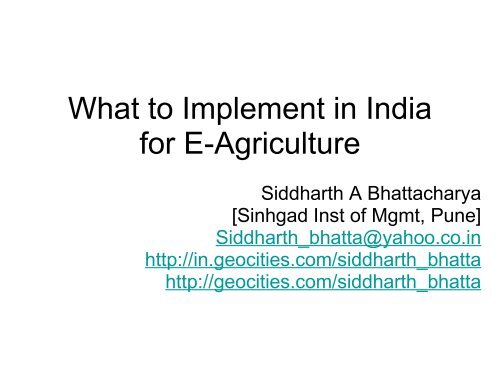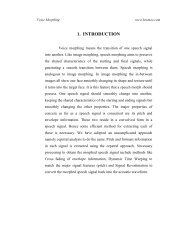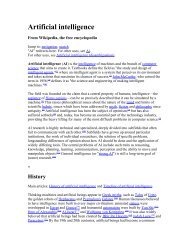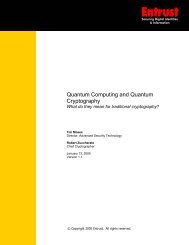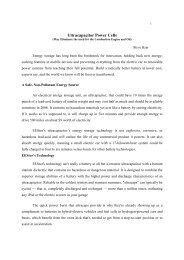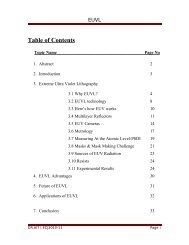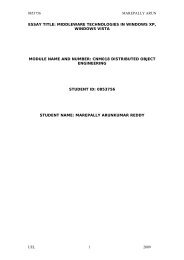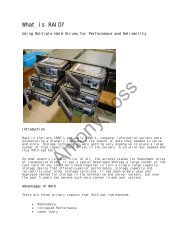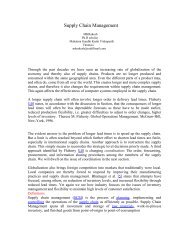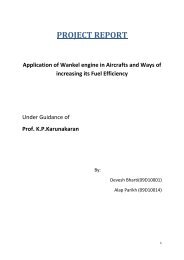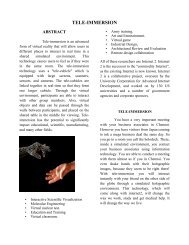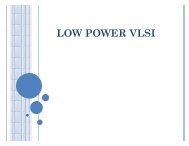eAriculture Presentation.pdf - 123SeminarsOnly
eAriculture Presentation.pdf - 123SeminarsOnly
eAriculture Presentation.pdf - 123SeminarsOnly
You also want an ePaper? Increase the reach of your titles
YUMPU automatically turns print PDFs into web optimized ePapers that Google loves.
What to Implement in India<br />
for E-Agriculture<br />
Siddharth A Bhattacharya<br />
[Sinhgad Inst of Mgmt, Pune]<br />
Siddharth_bhatta@yahoo.co.in<br />
http://in.geocities.com/siddharth_bhatta<br />
http://geocities.com/siddharth_bhatta
Geographic Information Systems<br />
(Gis) for Soil Resources<br />
• to use soil resources sustainably.<br />
• collecting a wider spectrum of data in a<br />
short span of time.<br />
• makes soil management<br />
o Less tedious<br />
o Less costly
Advantages<br />
• Better than labor- and time-intensive<br />
traditional on-site soil surveys and<br />
monitoring approaches<br />
• Asian countries are still in the process of<br />
evolving a GIS-driven baseline data, while<br />
building their human resources to<br />
strengthen their GIS capability in the<br />
future.
Why GIS?<br />
• The main Aim is counteracting the<br />
negative effects of development, such as<br />
soil erosion, soil salinity, soil pollution and<br />
flooding.<br />
• a significant tool to help countries manage<br />
their land and soil resource sustainably,<br />
restoring their productivity for future<br />
generations.
Applications of GIS<br />
• precision farming approaches<br />
• small-farm agriculture<br />
• GIS-based soil erosion models<br />
• land classification and suitability<br />
evaluation<br />
• remote sensing and GIS for soil resource<br />
management<br />
• Internet service system of agro-soil<br />
environmental information.
Precision Farming<br />
• Precision farming originally developed for large<br />
farming units, such as those found in the United<br />
States. has been adapted to the needs of smallscale<br />
farms in Asia, which in some countries<br />
have an average size of only one hectare (2.6<br />
acres).<br />
• three technology levels:<br />
o describing variability<br />
o using variable-rate technology (VRT) for adjusting<br />
agricultural inputs to site-specific requirements<br />
o applying a decision-support system (DSS).
How they do Precision Farming?<br />
• Japan has recently developed automated<br />
measuring variability within fields, using a<br />
real time soil spectrophometer.<br />
• Satellites collect the data.<br />
• It is now possible to apply precision<br />
farming to small as well as large farms,<br />
and make it part of Asian rural<br />
development programs.
Some more Facts<br />
• Taiwan has a strong island-wide soil testing service,<br />
Small-scale rice farmers in Taiwan improve their<br />
fertilizer applications by know the nutrient status of their<br />
soils, particularly with regard to nitrogen, phosphorus<br />
and potassium (N, P and K).<br />
• Decision support systems are being developed which<br />
will provide site-specific fertilizer recommendations.<br />
• Initially, detailed information for farmers will be provided<br />
through the existing agricultural information services.<br />
• Later, this information will be directly available to<br />
farmers over Internet.
Gis-Based Mapping and Modeling<br />
of Soil Erosion<br />
• Conventional surveys of soil erosion in the<br />
field are costly in time and labor.<br />
• to get a reliable estimate of the rate of soil<br />
erosion and the main factors influencing it,<br />
surveys of erosion usually have to cover<br />
several years.<br />
• GIS-assisted physical models are now<br />
available which can predict where erosion<br />
"hot-spots" are likely to occur.
Some Real Examples…<br />
• In the Mapawa catchment area in the<br />
Philippines, this approach was applied<br />
• The main erosion factor was found to be<br />
“rainfall intensity”. Road construction<br />
was also important. The model could thus<br />
be used to identify sites which were very<br />
vulnerable to erosion, and where<br />
conservation measures were urgently<br />
needed.
GIS – Satellite view<br />
• GIS could also be used to predict the<br />
effects of surface cover on the discharge<br />
of water and soil sediments from the<br />
catchment area. The rate of soil and water<br />
loss from bare soil was compared to<br />
vegetative cover with minimum<br />
conservation measures, the same cover<br />
with full conservation measures, and<br />
forest cover.
• There was a close agreement between<br />
predicted and observed measurements,<br />
which implies that the model is a valid<br />
predictive tool. Interestingly, it was noted<br />
that canopy cover was not very effective<br />
in containing erosion. What was important<br />
was cover which lay in direct contact with<br />
the soil surface.
Using Satellites to Monitor<br />
Changes in Land Use<br />
• All Asian governments have legal restrictions<br />
concerning the use of public land, especially the cutting<br />
of forest, and the conversion of forest to arable land. In<br />
practice, it is difficult to monitor what are usually remote<br />
areas, and detect changes in land use at an early stage<br />
before environmental damage has become serious.<br />
• Satellite remote sensing is an effective way of<br />
monitoring resource management and changes<br />
occurring over large areas. The ”Gram-Schmidt<br />
Orthogonalization (GSO)” technique is being used in<br />
Malaysia to detect and monitor changes in land use,<br />
using data transmitted by satellite.
Boon for Policy makers<br />
• This type of analysis is also very useful for showing the<br />
sustainability of different agricultural systems. Policy<br />
makers can only promote sustainable land use systems<br />
if they know which ones they are. GIS facilitates the<br />
classification of land into different land use classes, and<br />
can monitor the long-term impact of different kinds of<br />
land use.<br />
• In this way, policy makers can be helped to distinguish<br />
land where agriculture can be intensified or expanded,<br />
from land where rehabilitation and diversification are<br />
needed. The information from GIS is now becoming<br />
detailed enough to show which areas are suitable for<br />
specific crops.
Farmers & GIS<br />
• Farmers can also be a key source of<br />
information. Often the local knowledge of<br />
farmers is more relevant and useful than<br />
the academic knowledge of scientists. GIS<br />
can also show gaps in infrastructure, such<br />
as a scarcity of roads or marketing<br />
centers, that may cause agricultural<br />
development programs to fail in an area<br />
which otherwise seems suitable.
Disseminating the Information<br />
• Korea and Taiwan are pioneering the use of<br />
information technology in environmental<br />
management for agriculture. Sources of data are<br />
land use surveys, aerial photographs, detailed<br />
soil survey maps etc. Maps are generated from<br />
these sources and encoded in central computers.<br />
The system is linked to related institutes and<br />
centers throughout Korea and Taiwan, and is<br />
then made available on the Internet.
What is the Information on the web?<br />
• Internet users, including farmers or<br />
extension staff, can easily find information<br />
at a provincial, county or district level.<br />
Information include land use, drainage,<br />
soil type, soil depth and soil chemical<br />
properties. Recommendations for each<br />
type of land use are also being provided<br />
for farmers and other clients.
Future of GIS<br />
• In adopting GIS, it is necessary to identify the specific clientele whom<br />
it will be serving. These may be small- or large-scale farmers,<br />
extension staff, or institutions who will be adopting GIS. Will these be<br />
the small- or large-scale farmer, the extension worker, or an<br />
institution?<br />
• If farmers are the main beneficiaries of GIS, their socio-economic<br />
background must be considered.<br />
• Soil management based on GIS should have the marketing aspect<br />
and risk management factored in.<br />
• The benefits of participatory GIS development should be explored<br />
further.<br />
• A network for GIS should be established among Asian countries.<br />
• In developing a GIS-based system, a decision needs to be taken<br />
about the best mode of information dissemination, based on the<br />
country's present situation. This might be a decision support system<br />
(DSS), stand alone or web pages.<br />
• Farmers should be asked for feedback on the validity of the GISderived<br />
data.
Examples - Expert Systems<br />
• GRAIN MARKETING ADVISOR is an expert system for determining marketing<br />
alternatives and optimal strategies for grain producers. In this system individual<br />
farm conditions are considered. Information on storage and dryer availability,<br />
price level, price trends, government program eligibility, and timing are required<br />
as input data for deciding the optimal marketing recourse for the crops.<br />
• COMAX: provides information on integrated crop management in cotton. The<br />
system uses a combination of expert derived rules and results generated by the<br />
cotton crop simulation model.<br />
• GOSSYM: It requires external information such as weather data, soil physical<br />
parameters, soil fertility levels, and certain pest management information. Based<br />
on this input data, the system makes recommendations on the daily<br />
management decisions.<br />
• POMME: provides information about pest and orchard management of apples.<br />
External information such as weather data including forecasts and crop<br />
symptoms are utilized by the system to generate management decision<br />
recommendations.<br />
• PLANT/ds: supports the diagnosis of soybean diseases<br />
• SUBERMAX: is an expert system prototype that can help storage managers,<br />
especially during hectic harvest times by taking information on potato quality, bin<br />
environment, outside environment, bin facilities, and give recommendations.<br />
• SOYEX: is a soybean oil extraction expert system. Justifications and certainly<br />
factors for remedies help the user to select an effective solution.<br />
• FINDS: a Farm-level Intelligent Decision Support system was developed to
Gyandoot: Community-Owned Rural Internet Kiosks<br />
• Started in the Dhar district in central India having<br />
a population of 1.7 million; where 60% live below<br />
the poverty line.<br />
• The goal of the Gyandoot project was to<br />
establish community-owned, technologically<br />
innovative and sustainable information kiosks in<br />
a poverty-stricken, tribal dominated rural area of<br />
Madhya Pradesh. Gyandoot project was<br />
launched on January 1, 2000 with the installation<br />
of a low cost rural Intranet covering 20 village<br />
information kiosks in five Blocks of the district;<br />
later, extending to 11 more kiosks. For<br />
establishing the kiosks, villages that function as<br />
block headquarters were chosen.
Services offered at kiosks<br />
• Agriculture Produce Auction Centres Rates: Prevailing rates of prominent<br />
crops at the local and other recognized auction centres around the<br />
country are available on-line for a nominal charge of Rs. 5.<br />
• Copies of Land Records: Documents relating to land records including<br />
khasra (record of rights) are provided on the spot at a charge of Rs. 15<br />
• On-line Registration of Applications: Villagers had to make several visits<br />
to the local revenue court to file applications for obtaining income/caste/<br />
domicile certificates.<br />
• On-line Public Grievance Redress: A complaint can be filed and a reply<br />
received within 7 days for a cost of Rs 10.<br />
• Village auction site: This facility began in July 2000. It makes auction<br />
facilities available to farmers and villagers for land, agricultural<br />
machinery, equipment, and other durable commodities. One can put<br />
one's commodity on sale for a charge of Rs. 25/- for three months.<br />
• Transparency in government: Villagers could step on the same platform<br />
and understand the functioning of the government better.<br />
• Other services: Other services offered at the kiosks include on-line<br />
matrimonial advertisements, information regarding government<br />
programs, a forum for school children to ask questions, ask an expert, email<br />
(free for information on child labour, child marriage, illegal<br />
possession of land belonging to Scheduled Tribes, etc.)
Success of Gyandoot !!!<br />
• In the year 2000, the kiosk network was<br />
accessed 1,200 times for a variety of<br />
services.<br />
• That number reached nearly 9,000 within<br />
six months.<br />
• During the first 11 months, the 31<br />
Gyandoot kiosks were used nearly 55,000<br />
times.
Zinc Status of Rice Fields in<br />
Central Taiwan<br />
(Pink=Deficiency,<br />
Brown=Excess)
Some INDIAN initiatives !!!<br />
• The “Positive Solutions” Private Limited an A.P.<br />
based company working in association with A P<br />
Farmer’s Association has developed an<br />
agriculture-based portal, www.indianfarmers.org.<br />
• The site aims at disseminating information and<br />
educating farmers in various sectors of<br />
agriculture by introducing them to areas like IT<br />
and Biotechnology.<br />
• The latest happenings and news in the field of<br />
agriculture will also be available on the site.
More Indian Future Projects !!!<br />
• Agricultural Projects being undertaken by the Centre for<br />
Data Engineering at International Institute of Information<br />
Technology, Hyderabad, India, are:<br />
• Web-based Agricultural Expert Advice Dissemination<br />
System: In this project, an effort is being made to build a<br />
cost-effective agricultural information dissemination system<br />
to disseminate expert agriculture knowledge to the farming<br />
community to improve the crop productivity.<br />
• Pest Prediction Systems: In this project an effort to<br />
understand pest population dynamics and build pest<br />
prediction systems by applying data mining techniques on<br />
pest surveillance data set of Helicoverpa Armegira,<br />
Bacterial Leaf Blight, Groundnut leaf miner regarding<br />
Chickpea, Pigeonpea, Cotton, Groundnut, and Rice crops is<br />
being made. This project is carried out in collaboration with<br />
ICRISAT (The International Crops Research Institute for the<br />
Semi-Arid Tropics), Patancheru, Hyderabad (India) and
Changes in Soil Erosion between<br />
1987 and 1992,<br />
Wusan Watershed, Taiwan<br />
(Green=No Increase)
Technology @ Service<br />
• Web-based marketing:<br />
o B2C: A direct marketing system between<br />
farmers and consumers<br />
o B2B: Bridges farmers and wholesalers,<br />
substituting for fresh markets by providing<br />
virtual market places over the Internet.<br />
o Web-based marketing is typically successful in<br />
Korea.
Virtual Corporation<br />
• Small-scale farming is typical in the Asian region. It is a<br />
main cause of the inefficient agricultural productivity and<br />
the lack of its global competitiveness. A simple solution<br />
is to merge small-scale lands to a big scale one. The<br />
land ownership, however, makes it difficult as the<br />
number of landowning farmers increased based on<br />
modernization. One solution we can expect is to virtually<br />
integrate those small-scale farmers while keeping their<br />
financial independency.<br />
• For example, a group of farmers can purchase<br />
chemicals with cheaper price than they can when they<br />
order individually. Or, if they can share machineries, the<br />
total cost on them can be reduced. We can expect<br />
similar cost reduction in marketing, logistics, risk<br />
management etc. as merits of scale. To realize such
A Web-Based Camera Server System,<br />
Field Eye: User Interface for the Remote Camera System (Left and Middle),<br />
User Interface for the Automatically Acquired Image Database System (Right)
Mobile Phone-Based Web Applications<br />
Weather Database Access (Left) and Farm<br />
Management Diary (Right)
Fieldserver, Wireless Lan Autonomous Field Monitoring<br />
System
Coverage of a Region by Fieldservers
Plant Condition Diagnosis System
Navigation Search: Users Do Not Need to Use Keyboards
Web Marketing with Remote Camera
Some good News<br />
• NSE is listed in top ten global markets for<br />
Futures & Options segment.<br />
• The marked entry of Reliance as retailer<br />
for better<br />
o Intra country supply chain management of<br />
agri-produce & logistics management.<br />
o Better Distribution & Stocking mechanism.
Schematic Diagram of an Agricultural Grid System
Challenges !!! (to be overcome)<br />
• Constraints and Remedies for Effective Dissemination<br />
• Some of the major constraints delaying the spread of e-revolution to<br />
rural India<br />
• are listed below :<br />
• 1.Haphazard development : It is observed that some initiatives have<br />
already been made to provide IT based services to rural community.<br />
However, duplication of efforts are witnessed as most of the<br />
services revolve around limited subjects. Keeping in view the giant<br />
task involved, it is necessary to form a coordination mechanism to<br />
strive for a concerted effort to support farming community in the<br />
country. Such a coordination agency may only have advisory<br />
powers such as user interface, broad design, delivery mechanism of<br />
the content,<br />
• standards for setting up kiosks.<br />
• 2.User friendliness : The success of this strategy depends on the<br />
ease with which rural population can use the content. This will<br />
require intuitive graphics based presentation. Touch screen kiosks<br />
are required to be set up to encourage greater participation<br />
• 3.Local languages : Regional language fonts and mechanisms for<br />
synchronisation of the content provides a challenge that needs to<br />
be met with careful planning.
Challenges !!! (to be overcome)<br />
• Restrictions : Information content based on remote<br />
sensing and geographical information systems can<br />
provide timely alerts to the farmers and also improve<br />
the efficiency of administration. These applications can<br />
have a major impact on the farmers and help them to<br />
appreciate the potential of information technology.<br />
However, government’s map restriction policies often<br />
threaten to stifle the optimal utilisation of these tools.<br />
• Power Supply : In most of the rural India, power supply<br />
is not available for long hours. This will reduce the<br />
usefulness of the intended services. Since almost<br />
entire country receives sunshine for most part of the<br />
year, it is useful to explore solar power packs for UPS<br />
as well as for supply of power. The Ministry of Nonconventional<br />
Energy Sources may pay special attention<br />
in this area which can be a major contributor to the<br />
growth of IT in villages.
Challenges !!! (to be overcome)<br />
• Connectivity : Despite the phenomenal progress made in the recent<br />
years, the connectivity to rural areas still requires to be improved .<br />
Reliable connectivity is a prerequisite for a successful penetration<br />
of IT into rural areas. Many private ISPs are setting up large<br />
networks connecting many major towns and cities. Since some of<br />
these networks pass through rural areas, it is possible to provide<br />
connectivity to a large number of villages. Several technologies<br />
exist that can be utilised for connecting rural areas. Cable network<br />
is a possible medium for providing the last mile connectivity to<br />
villages.<br />
• Bandwidth : Even in areas where telephone and other<br />
communication services exist, the available bandwidth is a major<br />
constraint. Since internet based rural services require substantial<br />
use of graphics, low bandwidth is one of the major limitations in<br />
providing effective e-services to farmers. As already stated,<br />
networks with high bandwidth are being set up by several<br />
companies passing through rural segments which can be utilised.<br />
Until this materialises, a two pronged strategy of storing static<br />
information at the kiosks and providing dynamic information from<br />
remote locations can be examined. The graphic oriented content<br />
which does not change frequently, such as, demonstration clips for<br />
farmers, can be stored on the local drives at the kiosks and arrange
Some Challenges<br />
• Poor Broadband connectivity in rural areas because of absence of<br />
commercial competition. This also limits the IT extension in the rural<br />
areas, as the Internet is apparently an inevitable core infrastructure in<br />
IT utilization.<br />
• Factors to consider for IT in agriculture are as follows:<br />
• 1. How to adjust software to the special features of agricultural<br />
information<br />
• 2. How to enrich digital contents<br />
• 3. How to utilize the Internet, especially to reduce time and monetary<br />
costs<br />
• 4. How to provide easy-to-use systems for computer literacy?<br />
• 5. How to convince farmers of the potential benefits of IT?
Java Applet to Obtain Weather Data Mediated by Metbroker. Users Can<br />
Obtain Weather Data from Several Heterogeneous Weather Databases<br />
by Using This Application through Setting Query Options
Choosing the right Software<br />
• Software packages must be thoroughly<br />
evaluated before they can be used as a<br />
foundation for a new information system.<br />
• Check the functionality of the package in all<br />
aspects.<br />
• Flexibility aspects:<br />
o User friendliness, Hardware & Software Resources,<br />
Database requirements, Installation Effort,<br />
Maintenance, Vendor Quality and Cost.
Crop Models As Metbroker Applications Such As a Japanese Pear<br />
Growth and Disease Prediction and a Rice Growth Prediction
MetBroker Application<br />
• Shows Spatial Weather Data from a Region Over<br />
the Map. the Same Application Can Display<br />
Weather of Completely Different Databases. the<br />
Left Shows the Data for the Wakayama<br />
Prefecture from a Prefectural Local Database<br />
and Amedas for the Region, and the Right<br />
Shows the Data for the Korean Peninsula from<br />
the Seoul National University Weather Database<br />
and the Amedas DB of Japan. the Map Data Is<br />
Dynamically Downloaded from a Map Server in<br />
the Us, Using Chizubroker
Sample Metbroker Applet …<br />
• Metbroker Applet That Displays Extreme<br />
Weather Risk Using Circle Charts Over<br />
the Location of Observation Points. It<br />
Estimates the Conditions of Non-<br />
Observed Points As Well, Using Mesh-<br />
Interpolation. Metbroker, Dembroker and<br />
Chizubroker Are Jointly Used to Mediate<br />
Three Different Types of Databases
References<br />
• http://www.agnet.org
Any Feedbacks/Suggestions?<br />
Contact<br />
• Siddharth A Bhattacharya<br />
• Siddharth_bhatta@yahoo.co.in<br />
• http://in.geocities.com/siddharth_bhatta<br />
• http://geocities.com/siddharth_bhatta


